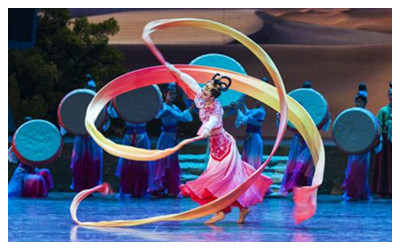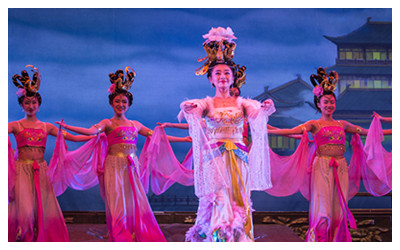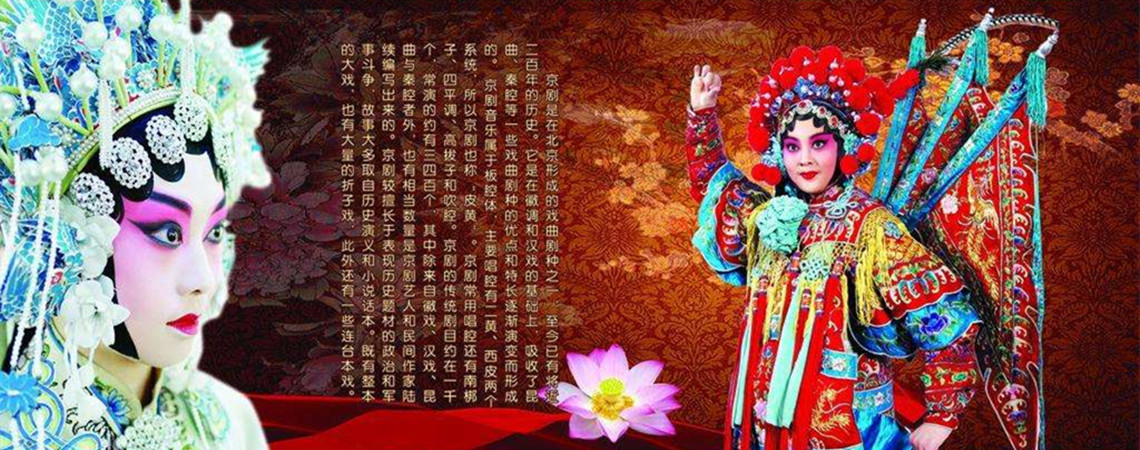The Jiyue dance, (Women Music Dance),originated from the Nuyue (women Music) of the slave society The women dancers were slaves who had become real professional musicians and dancers from their predecessors, the witches.The counterpart of Yayue (Elegant Music) was jiyue (Women Music). The two were like both wings of the Chinese dance art.
Jiyue Dance is a broad concept that included any ancient dance forms other than the Yayue dance. Such dances were mostly performed by professional dancers for entertainment. For instance, the wrestling dance and folk dance of the Qin and Han dynasties, the Nine Parts and Ten Parts dances, the Sitting and Standing Parts dances of the Sui and Tang dynasties, as well as the team dance of the Song Dynasty can all be put into the sphere of Jiyue Dance.
Performed by professional musicians and dancers, Jiyue dances were all entertaining. jiyue contributed greatly to the development of music and dance, representing the artistic level reached by ancient Chinese dancers. It actually formed the mainstream of Chinese dance in a long period. Nevertheless, it was always despised and looked down upon by the society The performers (called "Jigong") of such dances were regarded as the lower class and even enslaved by the upper class.
By the Zhou Dynasty, Women Music was even more popular The major reason for the collapse of rites and the disappearance of Elegant Music (Yayue) in the Eastern Zhou Dynasty was of course the declining power of the Zhou rulers. But in the aesthetic field, the prosperity of Women Music as the contrary of the Elegant Music (the Women Music was also called the "New Music" as in contrast to the ancient music) was actually an important element.

On the cover of a painted bronze pot from the Warring States Period is carved a women dancer With her hair worn in a bun and long sleeves, she seems gentle and ready to fly away in the wind. on another bronze pot with patterns of fishing and poaching, a woman musician is striking the stone instrument qin.
Raising her long sleeves, the girl looks charming and alive. These Fig.s bring us the wonderful dance scenes over 3,000 years ago.
The Han Dynasty brought great development to Jiyue, which secured the Han Dynasty's position as a major peak in the Chinese dance history. Some new forms of performances appeared in this period, such as the famous wrestling dance, "xiang" and "daqu". Also debuted were important dance shows like "the Dance of Pangu (plate drum)", "the Dance of Kerchief", and "the Dance of Bayu". Some musicians and dancers of this time are still remembered today. All these symbolized the arrival of the prosperity of the Chinese music and dance culture.
The most famous dancer of this time was perhaps
Zhao Feiyan. Originally a dancer in the family of Princess Yang'e, she was favored by Emperor Cheng of the Han Dynasty, who made her an imperial concubine and later the empress. Legends say that the reason she won so much favor from the emperor was her Superb dancing skills. Historical records say she "was light as a swallow and could dance on another one's palm". This might be exaggerated but all historical records acknowledged that she had a light and enchanting dancing gift.
Another woman dancer who won the favor of the emperor in the Han Dynasty was
Madame Li in the time of Emperor Hanwu. She was born to a home of musicjans and dancers, and her brother Li Yannian was a famous musician.
Although the society had entered the feudal times by the Han Dynasty, the Jiyue performers were still treated as slaves; they had no control over their life or freedom. Such a humble position was to accompany the Jiyue professionals for the whole of the feudal society. The nobles of the Han Dynasty used no more living people to accompany the dead.
The climax of the Tang Dynasty was a golden period in the development of Chinese dance, and it was also the prime time of the Jiyue dance. At that time, the jiyue performers with high singing and dancing skills could be found in all strata of society. The imperial court had the imperial performers, the army camp had the camp performers, the local governments had official performers, and private homes had family performers. It was the genre to keep the jiyue performers, who could range from just a few to a dozen, and even to thousands. The famous poet Bai Juyi led a quiet life at home when he was old. He also kept family performers who were called Xiao Man, Fan Su, Hong E, Zi Fang and others.
In the Sui and Tang dynasties, the "Yanyue" (referring generally to all music and dances entertaining banquets) which marked a peak of the Tang Dynasty music and dance Culture was mainly performed by Jiyue professionals. The varied content, Superb skills, vast teams, and the popularity in the society were both unprecedented and unrivaled in later times.
The more entertaining dances in this period were the Sitting and Standing Part jiyue and the Singing and Dancing Daqu .
The Sitting Part jiyue performers played in the front of the court and there were just six parts of them. The Standing Part Jiyue performers had eight parts and played beyond the sitting performers. The major shows included "Pozhen Yue", "Qingshan Yue", "Shengshou Yue", "Niaoge WanSui Yue", and "Longchi Yue". The New Tang Annals: History of Rites and Music recorded that Taichang (the minister in charge of music and dances) gave regular exams to the Sitting Part Jiyue performers, those unqualified were turned to the Standing Part. If they were still incompetent, the performers would be sent to learn the Yayue (Elegant Music). This showed that the artistic level was the highest with the Sitting Part jiyue performers.

The Singing and Dancing Daqu was a big-scale performance formed in the Tang Dynasty combining instrumental music, dance and singing. Among the shows, the traditional instruments from central China were used to play "Faqu", or pieces with a more gentle and elegant style. The number of Tang Dynasty Daqu was big and there were over 60 of them passed down the history. The most famous ones are "Liangzhou", "Ganzhou", 'jianqi", "Zhezhi", "Luyao", "Bomei", "Chunyingzhuan", "Yulinling", etc.
The jianwu (vigorous dance) and Ruanwu (soft dance) were the other two major types of the jiyue dances popular in the Tang Dynasty. These two also had quite a number of excellent works that were passed down through generations: the "Huxuan", "Huteng", "Jianqi", and "Zhezhi" of jianwu, and the "Wuyeti" and "Lanlingwang (King of Lanling) "of Ruanwu.
The representative work was "
Nishangyuyi" (The Dance in Feathery Clothing) which belonged to the Faqu category There were many beautiful stories about its origin. one of them says the work was secretly learned by the Emperor
Tangminghuang from the palace in the Moon. This manifested the love and praise of the people who had seen it.
The Jiyue of the
Tang Dynasty had a profound influence on the social life with its amazing creativity and left vivid images in various literary and art works -- poem, tales of marvels, painting, sculpture, etc. These images still draw the appreciation and imagination of today's people.

 On the cover of a painted bronze pot from the Warring States Period is carved a women dancer With her hair worn in a bun and long sleeves, she seems gentle and ready to fly away in the wind. on another bronze pot with patterns of fishing and poaching, a woman musician is striking the stone instrument qin. Raising her long sleeves, the girl looks charming and alive. These Fig.s bring us the wonderful dance scenes over 3,000 years ago.
On the cover of a painted bronze pot from the Warring States Period is carved a women dancer With her hair worn in a bun and long sleeves, she seems gentle and ready to fly away in the wind. on another bronze pot with patterns of fishing and poaching, a woman musician is striking the stone instrument qin. Raising her long sleeves, the girl looks charming and alive. These Fig.s bring us the wonderful dance scenes over 3,000 years ago.
 The Singing and Dancing Daqu was a big-scale performance formed in the Tang Dynasty combining instrumental music, dance and singing. Among the shows, the traditional instruments from central China were used to play "Faqu", or pieces with a more gentle and elegant style. The number of Tang Dynasty Daqu was big and there were over 60 of them passed down the history. The most famous ones are "Liangzhou", "Ganzhou", 'jianqi", "Zhezhi", "Luyao", "Bomei", "Chunyingzhuan", "Yulinling", etc.
The Singing and Dancing Daqu was a big-scale performance formed in the Tang Dynasty combining instrumental music, dance and singing. Among the shows, the traditional instruments from central China were used to play "Faqu", or pieces with a more gentle and elegant style. The number of Tang Dynasty Daqu was big and there were over 60 of them passed down the history. The most famous ones are "Liangzhou", "Ganzhou", 'jianqi", "Zhezhi", "Luyao", "Bomei", "Chunyingzhuan", "Yulinling", etc.  Ask Questions ?
Ask Questions ?